-
Posts
1,160 -
Joined
-
Last visited
Content Type
Profiles
Forums
Articles
Gallery
Downloads
Events
Posts posted by Goods
-
-
Les, that cable knife came out really nice.
-
I hadn’t considered that.
I did make the mistake of stacking them up rotated 45degrees after showing my wife. They look pretty good that way, but I’m not sure I have enough time to make to more with the other work that’s still to be done.
Keep it fun,
David
-
Finally got back in the forge tonight and got the florets done:
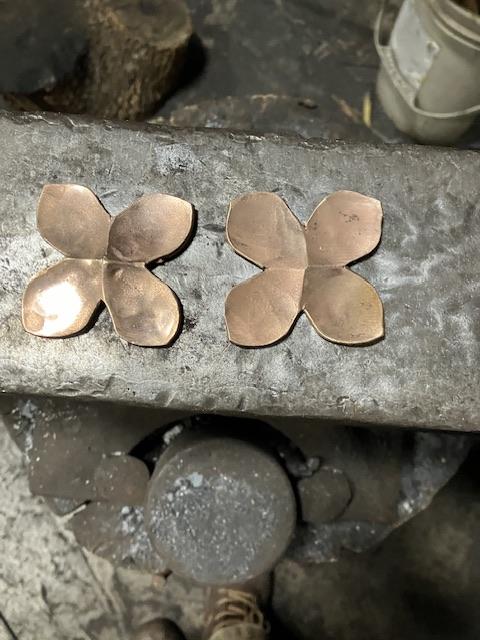
I like the center form of the one on the left and the petal shape of the other. Best to leave them the way the are at this point!
Keep it fun,
David
-
White Fox, you may be able to judge if the weld is good by tapping on it or dropping it on the anvil from an inch or two.
My second WI hammer had a bad weld on the face which looked good. It felt strange to forge with and it sounded odd tapping on the anvil, before it cracked and fell off.
Keep it fun,
David
-
If you drill then cut, you loose some material and the dies don’t make a true round of the drilled size.
For round swages, square the blocks up, line them up, put small tack welds on them, drill them to size clamped tightly, then grind the weld back off. Finally, to avoid marring the surface smooth off the transition from the flat face to the swage radius. The larger the transition radius from face to swage the more material that can be move in forging without marring or creating cold shunts.
Keep it fun,
David
-
Billybones, it’s a one piece 1/2” square bar with the center 4” forged round, with a 1” section on either side of the round left square and the leaves forge welded on there. Beyond the leaves, I twisted it 135degrees on each end which was forge to octagon till the last 3” on each end. No sockets?
Keep it fun,
David
-
Worked on the picket some more today:
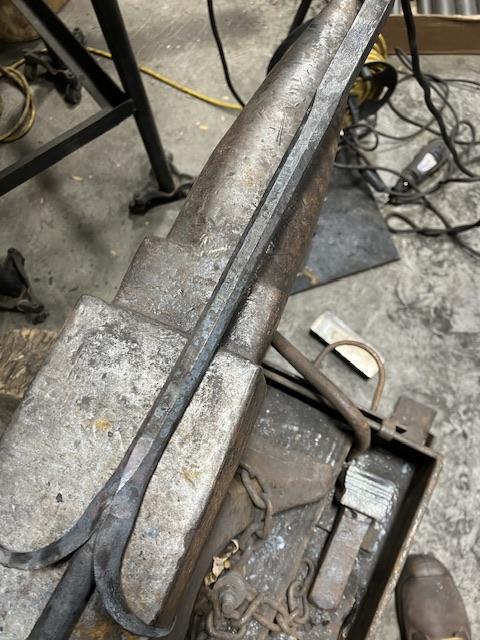
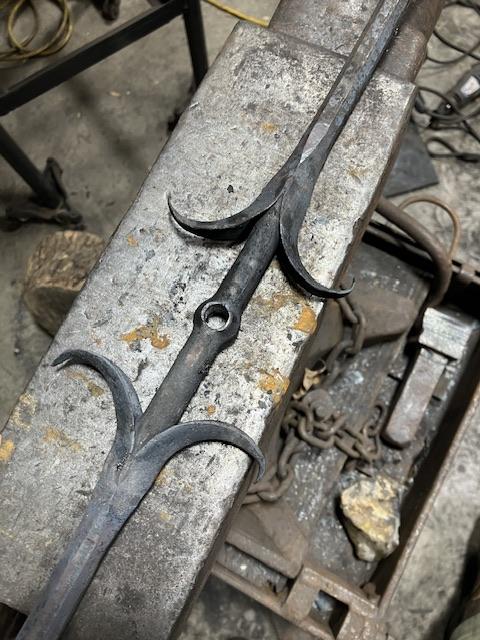
I almost got the first floret done when work called. I turned the fire off, but didn’t take it out:
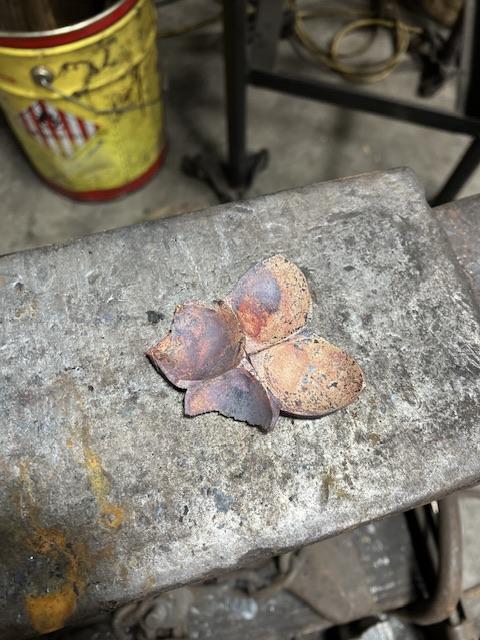
Lesson learned! Well, maybe the next ones will be mor consistent… I could always forge a hungry caterpillar to add this to another arrangement and make it work
 .
.
Keep it fun,
David
-
So many options, so little equipment… no stick welder. I’ve never torch welded, but I have purchased a torch set. I’m going to have to take off work early one of these days to get the tanks.
Keep it fun,
David
-
Tim, oh, I with you! Tig would be ideal, mig would probably be ok… if I was any good at it! (For clarification, this was flux core not true mig welding.) The funny thing is, the first welding I learned was Tig welding and I’m still much better with that that true mig or flux core welding. I just have equipment handicaps.
Keep it fun?
David
-
Shainarue, one thing I will definitely recommend is that whatever direction you go on the cheap, make it so that when the time and money comes to improve it, you won’t waste too much of what you put into it now. Especially the time, you can always make more money…
As for the fabric walls, I’ve spent a lot of time thinking about that for my own shop. I was looking at canvas drop clothes from HF. The cost was way below what I could buy the raw fabric myself. As for the flame resistance, soak the canvas in a saturated solution of water and Borax (20mule team) and let if air dry. I also heard that adding Boric Acid to the mix resists smoldering, but I haven’t researched that one.
Congratulations on the new property (if it works out). Personally, I would not want to be buying right now. Strange market, both high prices and high interest rates
 .
.
Keep it fun,
David
-
Tim, the weld itself was not a big issue. I just brought it up to temperature real slow. My issue was two fold. First, the cross section of the leaves was tapered center to edges. Second, the leave we to small to wire up and not have the wire in the weld, so I put a spot of mig weld at the corner. Both of these made it very difficult to bend the scarf in. I also had issue with the parent bar thinning from scaling due the the number of welding heats the blend the weld. I ended up using an isolated heat to upset in the areas (and a lot of file clean up).
All lessons learned for future projects.
About the swage block, I’ve seen a couple sources for water jet cut swage blocks from mild steel, but they’re still pricey. Hopefully I’ll run across what I want at the “right” price when I’m actually convinced I need one.
Keep it fun,
David
-
Tim, is that swage block 2” A36 water jet cut? If so how do you like it?
I got the forge welding done on the picket last night:
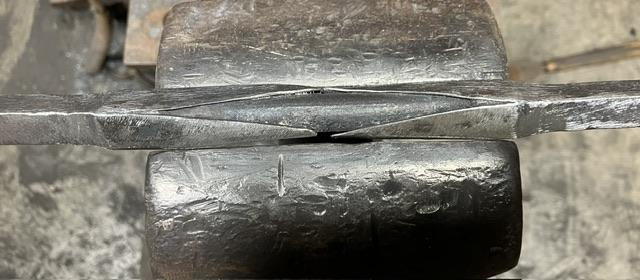
It took way longer and was way trickier than I thought it would be. It’s not as clean as I would like, but it passes… on to the next step, whenever I get another forging session.
Keep it fun,
David
-
Alexandr, you’re always a hard act to follow! Beautiful as always!
I got some time in the shop today and started on a single picket for a railing. (One of the smiths in our group is redoing his and asked for one for all the smiths, with their own style and touch mark.) I’m maybe half way there:


I’m probably over doing it, but I guess that’s my style…
I’ve got to clean it up, before I can got to the next step of forge welding.
Keep it fun,
David
-
I’m assuming you’re using an oxypropane torch? In not, I’m very curious on the setup?
Keep it fun,
David
-
I brought a couple scrap shafts and some injection machine draw bars home:
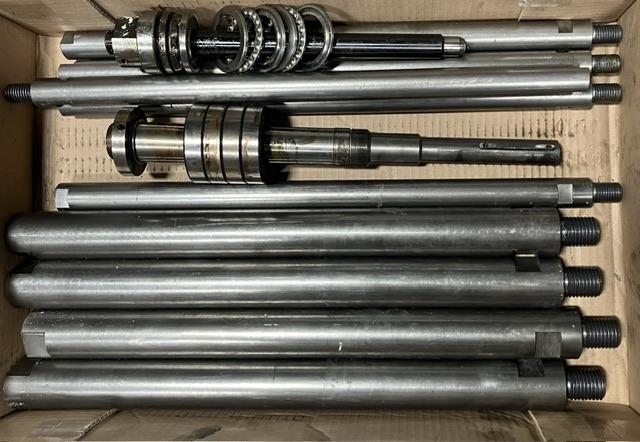
The stepped shaft is 1-1/2” to 1” diameter and the other is 1” diameter. The draw bars are 50mm and 30mm diameters, but only sparked as mild steel. (The stepped shaft and bearings went to “iron in a hat” at today’s hammer-in.)
Keep it fun,
David
-
Good day today at our local chapter’s Hammer-in. We work with two new first timers and I got time to forge a steak flipper for my neighbor and a started another BBQ fork:

Sorry, I don’t have a work in progress picture of the fork.
Keep it fun,
David
-
I’m having a hard time wrapping my head around the situation. I can’t even imagine losing my own boys.
I have the most heart felt remorse for the loss that I can’t fully even grasp…
The most sincere condolences,
David
-
How long ago was that snow you were talking about in Baton Rouge? My wife has a story of driving with almost a hallucination fever from the measles in LA when she was growing up there. It’s the only time she ever drove in snow until she came up here for college and I derailed here life plan…
Keep it fun,
David
-
I almost made a joke about cubit earlier, too bad I didn’t. It was my understanding the a cubit was from finger tip to elbow. (Big difference between me and wife in cubit length.)
Keep it fun,
David
-
No, it means every forge is different. When you fire it up the color in the forge will tell you more about your forge than we can by guessing.
-
The hot spots are usually under the burner, but every forge is different. On my two burner gas forge, when it’s cranked up high, there is a small cold spot directly below the burners. It’s a tunnel forge that doesn’t have a lot of height, so the gas isn’t all burnt when it hits the floor and actually cools a two small spots…
Keep it fun,
David
-
I’m good with either metric, fractional inches, or 1/1000”. Everything at work is in metric, but a lot of the machinists I deal with all think in 1/1000”. I’m converting in my head close enough for blacksmith work all the time.
keep it fun,David
-
Forge welding a handle on defeats the purpose. The handle is to make it easier to move the work piece around. If you have to move it around at forge welding temperature to put the handle on, you should already have a different solution. If if have good fitting tongs for 1-1/2” or 2” diameter cable and you comfortable working with those tongs, stick with that. If not, make good tongs for that size, weld a long handle on, or weld a stubby handle on that will fit in the size tongs you have. Lots of options, but don’t make it harder than it needs to be.
(Some times it’s fun doing things the hard way, but I don’t think this is the place for that! You don’t want you to loose control of you billet when it’s at forge welding temp, or ever really!)
Keep it fun,
David
-
31 minutes ago, Pigsticker said:
Im getting my knife badge this weekend from the troop and an extra smore
Is this sarcasm, or did I miss something? (I can be slow on the uptake sometimes…)


Show me your shop!
in Building, Designing a Shop
Posted
Your forget table look easy to move. Put in the corner if that is the most efficient for the majority of your forging. Just move it out when you have a long project that requires it.
Keep it fun,
David